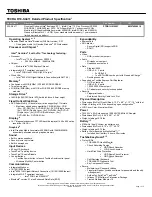
Part III: Appendixes
Glossary
248
K
keyboard:
The device you use to type information into the computer.
Each key on the keyboard is a switch that is activated when you
press it. The switch sends a specific code, representing the character
printed on the key, to the processor.
keyboard shortcut:
A key or combination of keys that you use to perform
a task instead of using a pointing device such as the AccuPoint.
kilobyte (KB):
A unit of data storage equal to 1024 bytes. Its
abbreviations (K and KB) are taken from the Greek word kilo,
meaning 1000, although the abbreviation refers to 1024, or 2 raised
to the 10th power. See also
byte
.
L
legacy device:
In a PC, an expansion device or card that does not have
the ISA Plug and Play capability built into it.
light emitting diode (LED):
A semiconductor device that emits light
when it receives an electric current. Used for indicators like the disk
activity light.
liquid crystal display (LCD):
A type of display that uses a liquid
substance between two transparent electrode panels. When an
electric current passes through the electrodes, the molecules in the
liquid form a crystalline pattern that polarizes the light passing
through it. A filter over the electrodes permits only non-polarized
light to pass to the surface of the display, creating light and dark
pixels.
load:
To move information from a storage device (such as a CD-ROM)
into memory for processing.
local
bus:
A type of bus that connects devices directly to the
microprocessor. Because there are no wires between the CPU and
the device, information is passed at a much greater speed than
through a traditional bus. See also
bus
.
logical
drive:
A section of a disk that is recognized by the operating
system as a separate disk drive. A system’s logical drives may differ
from its physical drives. For example, a single hard disk drive may
be partitioned into two or more logical drives.
low-density disk:
see
double-density disk
.
Summary of Contents for 8000 series
Page 21: ...xxi ...
Page 22: ......
Page 43: ...Part I Getting to Know Your Computer To Begin When and how to turn off the computer 19 ...
Page 107: ...Part I Getting to Know Your Computer Using Drives Playing a DVD video 83 ...
Page 174: ......
Page 176: ...Chapter Using TSETUP 153 Using Hardware Setup 154 ...
Page 210: ...Chapter Industry standard architecture 187 System management 189 Security management 196 ...
Page 224: ......
Page 226: ...Appendix Built in features 203 Optional accessories and devices 211 Specifications 214 ...
Page 239: ...Part III Appendixes Features and Specifications 215 ...
Page 240: ...Appendix ...
Page 249: ...Part III Appendixes System Resources 225 ...
Page 250: ...Appendix ...
















































